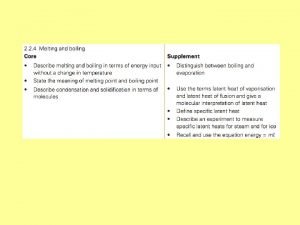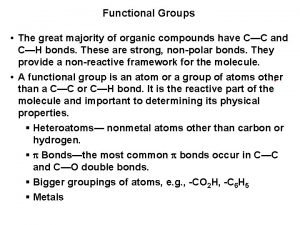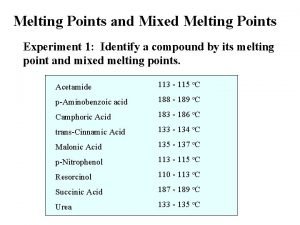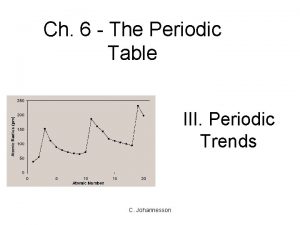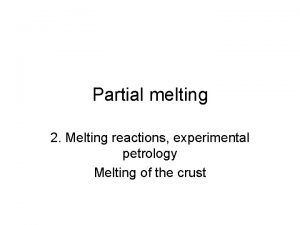Melting point apparatus What is melting point Melting










- Slides: 10

Melting point apparatus

What is melting point? Melting point is the temperature at which a substance changes from a solid to a liquid state, via melting. Ice is the most common example, using heat the solid ice melts to its liquid state of water.

What is melting point range? Melting point range is the temperature range at which a substance changes from a solid to a liquid, i. e. by melting. The temperature range consists of 2 temperature points. Temp 1 = The temperature at which the solid substance starts to melt i. e. the first drop of liquid appears. Temp 2 = The temperature at which melting is complete i. e. the substance is now in a liquid state. Melting point can be used for the identification of a substance, as every substance as its’ own specific melting point range.

Melting point apparatus • The digital melting point apparatus is designed for the fast and accurate determination of a substances’ melting point. • This specific melting point apparatus (Stuart SMP 30) can hold 3 samples simultaneously with the aluminium heating block.

• The solid sample is contained within specialised tubes called capillary tubes designed for melting point determination. • Once placed in the heating block the capillary tubes are illuminated by bright LED lights, in order to view the melting of the substance taking place within the tube. • Electricity is supplied to the apparatus at approx. 120 – 230 volts, this electricity heats the micro furnace/heating block which then melts the sample.

• For the melt cycle to occur the apparatus first heats up to the pre-programmed plateau temperature (max temp) at a desired rate (slope) before stabilising at the plateau temperature for 120 seconds. • An alarm/beep indicates that the apparatus is ready to start to heat the sample at the pre-programmed rate (e. g. 0. 5˚ - 10˚C/min). • Once the sample has melted and the cycle stopped, the apparatus automatically cools to the ambient temperature. • Temperature accuracy of approx. – +/- 0. 5 @ 50˚C +/- 1 @ 100˚C

How to prepare a sample for melting point analysis? • Obtain the solid sample that is required for melting point analysis e. g. paracetamol tablet. • A mortar and pestle is used to crush the tablet into a fine powder.

• A capillary tube is then used to ‘scoop’ a small amount of the solid sample into the tube. • The sample should cover approx. 1 cm of the bottom of the capillary tube. • The capillary tube can be gently ‘tapped’ against the work surface to ensure the sample is at the bottom of the tube. • The sample is now ready to be placed into the apparatus for melting point determination.

• The melting process must be observed by the ‘naked eye’ through the lens in order to record the MP range. The temperature at which the first drop of liquid appears is noted and then when all of the solid has melted i. e. the substance is now in its’ liquid state, the temperature is noted again. Example – paracetamol has a MP range of 168 - 172˚C. • It is recommended that samples are analysed in triplicate for accuracy.

Melting point is the temperature at which at substance changes from a solid to a liquid state. Melting point range – temp solid starts to melt to the temp where liquid is formed. What have I learned? Melting point can be used in the indication of a substance, as every substance has a specific MP range. Electricity is used to heat the micro furnace/heating block, which melts the solid sample.
 Congruent melting point
Congruent melting point Boiling point and melting point
Boiling point and melting point Intermolecular forces of functional groups
Intermolecular forces of functional groups What is anything that takes up space and has mass
What is anything that takes up space and has mass The melting point of naphthalene is 80
The melting point of naphthalene is 80 Mixed melting points
Mixed melting points Reactive
Reactive Physical state of covalent compounds
Physical state of covalent compounds Diamond melting point
Diamond melting point Melting point of water
Melting point of water Melting point trend
Melting point trend

